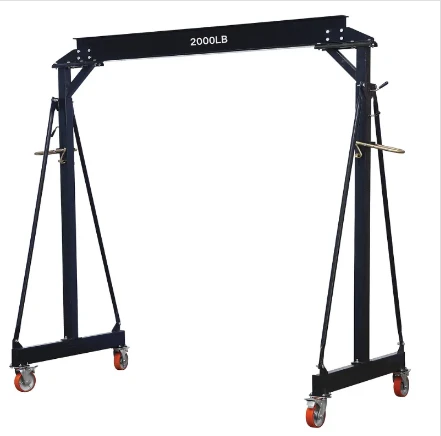1-ton gantry crane for efficient lifting and transportation solutions in industrial settings
Understanding One-Ton Gantry Cranes Versatility and Applications
In the realm of material handling and industrial operations, gantry cranes have emerged as indispensable tools. Among them, the one-ton gantry crane stands out for its versatility, ease of use, and efficiency. This article delves into the features, advantages, and typical applications of one-ton gantry cranes.
What is a Gantry Crane?
A gantry crane is a type of crane that is mounted on a structure supported by legs, allowing it to move along rails, usually situated along the ground. The design consists of a horizontal beam (or girder) supported by two or more vertical posts, with wheels or casters that facilitate mobility. This design allows gantry cranes to operate in open areas, making them ideal for outdoor applications and workshops.
Key Features of One-Ton Gantry Cranes
1. Load Capacity The one-ton gantry crane is specifically designed to handle loads weighing up to 1,000 kilograms. This makes it suitable for various applications, from light assembly tasks to lifting and moving heavy equipment.
2. Adjustability Many one-ton gantry cranes come with adjustable height features, providing flexibility to the user. Depending on the specific requirements of the task, the crane can be raised or lowered to achieve the desired clearance.
3. Mobility Equipped with wheels, these cranes can easily be moved from one location to another. This mobility is particularly advantageous in dynamic work environments where tasks may require shifting equipment frequently.
4. Material Choices One-ton gantry cranes are typically constructed from durable materials such as steel or aluminum, ensuring longevity and stability. Aluminum variants are particularly favored for their lightweight nature, enhancing mobility without compromising strength.
5. Safety Features Safety is paramount in any lifting operation. One-ton gantry cranes are equipped with various safety features such as locking mechanisms, limit switches, and emergency stop buttons. These precautions help reduce the risk of accidents and ensure the safety of the operator and surrounding personnel.
Advantages of One-Ton Gantry Cranes
one ton gantry crane

- Cost-Effective Solution Compared to larger cranes, one-ton gantry cranes offer a more affordable option for businesses that do not require extensive lifting capabilities. Their lower price point makes them accessible for smaller workshops and operations.
- Ease of Assembly Many one-ton gantry cranes are designed for quick assembly and disassembly, allowing users to set them up on-site without the need for specialized tools or equipment.
- Versatility These cranes can be employed in a wide range of settings, including warehouses, manufacturing plants, construction sites, and automotive repair shops. Their adaptability to different tasks makes them a valuable asset in various industries.
Typical Applications
One-ton gantry cranes find utility in numerous applications, reflecting their versatility. Some common uses include
- Manufacturing In manufacturing settings, one-ton gantry cranes are used to move heavy components during assembly processes. This can include lifting machinery, motors, or large parts into place.
- Construction In construction sites, they are often used for hoisting materials, framing, and equipment that require precise placement without the need for bulky overhead cranes.
- Maintenance and Repair In automotive and mechanical workshops, one-ton gantry cranes are invaluable for lifting engines, transmissions, and other heavy components during repair and maintenance operations.
- Shipping and Receiving In warehouses, these cranes are used to load and unload goods onto delivery trucks, streamlining logistics and improving productivity.
Conclusion
The one-ton gantry crane is a testament to efficiency and versatility in material handling. Its design allows for flexibility across various industrial applications, making it a critical tool for many businesses. As operations continue to grow in complexity, the demand for practical solutions like the one-ton gantry crane is set to rise, ensuring that it remains a staple in the material handling sector for years to come. Whether for lifting, moving, or positioning loads, this crane stands ready to meet the diverse needs of modern industry.
-
Unlock Seamless Relocation with Our Heavy Equipment Moving ExpertiseNewsJun.06,2025
-
Unleash Unrivaled Flexibility with Our Adjustable Gantry CraneNewsJun.06,2025
-
Unleash Heavy-Duty Efficiency with Our Industrial Gantry Crane SolutionsNewsJun.06,2025
-
Revolutionize Steel Handling with Our Magnetic Lifter RangeNewsJun.06,2025
-
Master Equipment Mobility with Premium Machinery Mover SolutionsNewsJun.06,2025
-
Elevate Your Material Handling with Magnetic Lifter TechnologyNewsJun.06,2025
-
YS Permanent Lifting Magnets: The Smarter Way to Handle SteelNewsMay.22,2025
